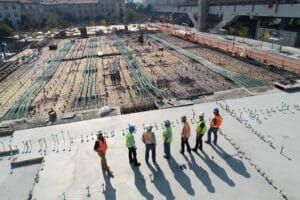Ground-penetrating radar, commonly called GPR, is a geophysical model of locating underground utilities, including water, electric cables, sewer lines, voids, objects, and soil composition. This technology captures clear images of subsurface structures using radio waves and in a minimally invasive way. GPR allows construction crews to pinpoint the location of critical utilities without disturbing the ground.
How the GPR Works
Ground-penetrating radar works by using energy waves in the wavelength between 1 to 1000 MHz. The GPR requires two pieces of equipment – the receiver antenna and the transmitter. The transmitter sends energy signals to the soil underneath and other composite materials below the ground.
The transmitter sends pulse signals underground and records the echoes that emanate from the subsurface materials, structures, and objects. Once the electromagnetic impulse hits an object underneath, the object’s density refracts, reflects, and scatters the signal.
The receiving antenna recognizes the scattering signals and records the variations. The GPR system has software that translates the signals into images of sub-surface objects and structures.
Reasons to Use Ground-Penetrating Radar
Ground-penetrating radar is used by construction crews, utility providers, mining personnel, and geologists to detect underground utilities, objects, and structures. Beyond this, the ground-penetrating radar has diverse applications.
GPR offers a non-destructive way of surveying an area before construction or excavation begins. This sub-surface imaging tool proves instrumental for detecting underground pipes, conduits, and even hollow voids. And because the technology is cost-efficient and non-invasive, ground-penetrating radar has become a go-to tool in multiple sectors.
Here are Seven Reasons to Use Ground-Penetrating Radar:
1. Ease of Execution
One of the main advantages of ground-penetrating radar is its ease of execution. With the right equipment and a trained operator, you can survey a large tract of land faster than other utility locating methods.
2. Superior Detection
Ground-penetrating radar can detect anomalies in soil, rock, and voids. It can also locate metallic and non-metallic utilities, determine soil composition, and detect variations in ground composition.
GPR is Capable of Detecting the Following Materials:
- Metal
- Concrete
- Clay
- Water
- PVC
- Plastic
- Wood
GPR can also notify the operation of any recent activities that may have altered the soil composition, including the presence of foreign materials.
3. Kick-Starting Projects
Another reason to use a GPR locator is that it provides a starting point during construction projects. If you ascertain the location of critical underground utilities before you start your construction, the process can go on quite smoothly.
Once you identify crucial utilities underground – septic tanks, sewer lines, electric cables, telecom, gas – you can then build your structure around them.
4. Safety
Underground utilities like sewer lines, gas, electric cables, and water are potentially hazardous. Gas lines can cause explosions and exposed electric lines may cause electrocution.
It’s the responsibility of every contractor and real estate developer to provide a safe work environment that’s free from harm. GPR enables you to quickly and safely locate hazardous utilities like gas lines and electric cables without exposing crew members to increased danger through more invasive utility locating practices.
5. Avoid Costly Damages
Undertaking construction projects without locating underground utilities can be potentially hazardous. You may interfere with electric cables, damage sewer lines, or cause significant damage to underground water or gas utilities.
Floods, fires, and explosions may occur when you inadvertently interfere with underground utilities, leading to a lot of damage to building equipment and materials.
Damage prevention is usually cheaper than repairs and maintenance. So, invest in a reliable and professional utility locating system before construction begins.
6. Accurate Results
Utility lines and maps are designed with the best intentions. However, they aren’t always accurate. Many times, utility maps are made out of old and outdated records, making them inaccurate and archaic. So, invest in a professional, up-to-the-minute tracking solution for all your construction needs.
One advantage of GPR is that it enables you to get accurate results of all the major utilities with a 97% accuracy rate at a depth of 13 feet. This survey tells you important information about the location of crucial utilities. GPR can detect a wide range of underground materials, not just conductive materials.
7. Potential Obstacles
People always know what to look out for during utility daylighting. Crew members and construction personnel always look out for sewer lines, pipes, cables, and waterways.
Unfortunately, during surveying, some objects and structures may not be evident. That’s because they’re either naturally occurring or because the surveying was not conducted professionally. Without a GPR survey, some naturally occurring materials, abandoned lines, and concrete structures may take you by surprise.
GPR Applications
Because of its accuracy and ease of locating critical utilities like water, wastewater, gas, telecom cables, and electrical lines. GPR has a wide range of commercial, residential, and industrial applications:
- Utility Mapping: Contractors and utility companies use ground-penetrating radar to detect underground pipes and cables, including unmapped infrastructure.
- Law Enforcement: GPR can help law enforcement officials locate hidden drugs, weapons, and cash, as well as hideouts and tunnels.
- Geophysical Surveys: GPR can collect and transmit crucial data for geophysical studies, thus helping engineers and geologists locate bedrock and groundwater. It also helps geologists distinguish different strata. GPR can also locate soil water infiltration and measure the thickness of ice underground.
- Structural Assessments: Since the GPR technology can locate cracks, voids, and infiltrations, it can provide accurate results and determine structural integrity and damage. This data can help engineers and surveyors undertake remediation actions during mining, excavations, and other critical land-use practices.
- Cemetery Mapping: Since the GPR technology can locate soil disturbances and buried objects, it can help researchers and archaeologists trace lost bodies and graveyards. The ground-penetrating radar can help planners locate and plot new graves, especially in areas with no grave records.
- Environmental Conservation: The GPR technology can locate hidden environmental hazards, including hidden toxic materials. GPR provides information on the direction of contamination material, helping environmentalists find and remove contaminants with little damage to nearby flora and fauna.
DFM Development Services – Superior Ground-Penetrating Radar Services
DFM Development Services provides professional services in the real estate and land development sector, including bond management, permit expediting, traffic control plans, environmental compliance, and dry utility coordination.
We have been a trusted provider of ground-penetrating radar services throughout Maryland, Virginia, and Washington D.C., routinely utilizing the technology for utility surveying, subsurface utility designation, and dry utility coordination projects.
Contact us to unlock and unleash the power of GPR.




